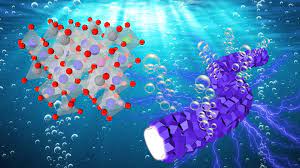
Hydrogen can power vehicles while emitting nothing but water. Hydrogen is also an important chemical for many industrial processes, most notably in steel making and ammonia production. Using cleaner hydrogen is highly desirable in those industries.
A multi-institutional team led by the U.S. Department of Energy's (DOE) Argonne National Laboratory has developed a low-cost catalyst for a process that yields clean hydrogen from water. Other contributors include DOE's Sandia National Laboratories and Lawrence Berkeley National Laboratory, as well as Giner Inc.
"A process called electrolysis produces hydrogen and oxygen from water and has been around for more than a century," said Di-Jia Liu, senior chemist at Argonne. He also holds a joint appointment in the Pritzker School of Molecular Engineering at the University of Chicago.
Proton exchange membrane (PEM) electrolyzers represent a new generation of technology for this process. They can split water into hydrogen and oxygen with higher efficiency at near room temperature. The reduced energy demand makes them an ideal choice for producing clean hydrogen by using renewable but intermittent sources, such as solar and wind.
This electrolyzer runs with separate catalysts for each of its electrodes (cathode and anode). The cathode catalyst yields hydrogen, while the anode catalyst forms oxygen. A problem is that the anode catalyst uses iridium, which has a current market price of around $5,000 per ounce. The lack of supply and high cost of iridium pose a major barrier for widespread adoption of PEM electrolyzers.
The main ingredient in the new catalyst is cobalt, which is substantially cheaper than iridium. "We sought to develop a low-cost anode catalyst in a PEM electrolyzer that generates hydrogen at high throughput while consuming minimal energy," Liu said. "By using the cobalt-based catalyst prepared by our method, one could remove the main bottleneck of cost to producing clean hydrogen in an electrolyzer."
Giner Inc., a leading research and development company working toward commercialization of electrolyzers and fuel cells, evaluated the new catalyst using its PEM electrolyzer test stations under industrial operating conditions. The performance and durability far exceeded that of competitors' catalysts.
Important to further advancing the catalyst performance is understanding the reaction mechanism at the atomic scale under electrolyzer operating conditions. The team deciphered critical structural changes that occur in the catalyst under operating conditions by using X-ray analyses at the Advanced Photon Source (APS) at Argonne. They also identified key catalyst features using electron microscopy at Sandia Labs and at Argonne's Center for Nanoscale Materials (CNM). The APS and CNM are both DOE Office of Science user facilities.
"We imaged the atomic structure on the surface of the new catalyst at various stages of preparation," said Jianguo Wen, an Argonne materials scientist.
In addition, computational modeling at Berkeley Lab revealed important insights into the catalyst's durability under reaction conditions.
The team's achievement is a step forward in DOE's Hydrogen Energy Earthshot initiative, which mimics the U.S. space program's "Moon Shot" of the 1960s. Its ambitious goal is to lower the cost for green hydrogen production to one dollar per kilogram in a decade. Production of green hydrogen at that cost could reshape the nation's economy. Applications include the electric grid, manufacturing, transportation and residential and commercial heating.
"More generally, our results establish a promising path forward in replacing catalysts made from expensive precious metals with elements that are much less expensive and more abundant," Liu noted.
This research was published on May 12 in Science and was supported by the DOE Office of Energy Efficiency and Renewable Energy, Hydrogen and Fuel Cell Technologies Office, as well as by Argonne Laboratory Directed Research and Development funding.
In addition to Liu, Argonne authors are Lina Chong (now at Shanghai Jiao Tong University), Jianguo Wen, Haiping Xu, A. Jeremy Kropf, Wenqian Xu and Xiao-Min Lin. Authors from Berkeley Lab include Guoping Gao, Haixia Li and Ling-Wang Wang. The author from Sandia Labs is Joshua D. Sugar. Contributors Zach Green and Hui Xu are from Giner Inc.